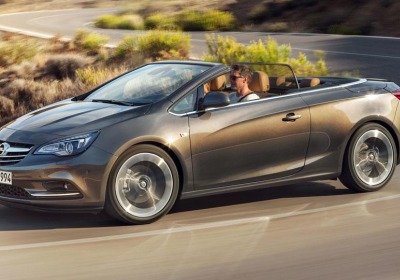Opel reveals Cascada convertible
Wed, 17 Oct 2012
Opel, General Motors' financially embattled European unit, has revealed its new midsize Cascada convertible in a series of photos. The car goes on sale in early 2013.
The two-door soft top, which is widely expected to be sold in North American by the Buick brand, enters the Opel lineup as a replacement for the Astra TwinTop. The Cascada takes some of its styling inspiration from the range-topping Opel Insignia.
Unlike its predecessor, which used a folding metal hardtop, the Cascada uses a fabric roof that can be opened in 17 seconds-both remotely at standstill via a button on the key fob and at speeds up to 30 mph via a dashboard-mounted switch.
At 184.9 inches long and 72.8 inches wide, the Cascada is one inch longer and wider than the four-door Astra sedan and its U.S. counterpart, the Buick Verano.
Opel is making much of the Cascada's dimensions, pointing out that it is longer than the Audi A5 convertible, the suggestion being that the Cascada will offer more metal for the money than premium-brand convertibles. Official pricing has yet to be announced, although Opel says the Cascada will be priced higher than the Astra TwinTop, in a move reflecting upper-market aspirations.
With the roof raised, trunk capacity is put at 12.4 cubic feet, or just 2.8 cubic feet less than the Astra sedan. With the roof stowed, storage space is cut to 9.9 cubic feet. However, Opel says it will offer an optional FlexFold system that uses an electronic mechanism to fold the rear seats in a 50:50 split, creating more cargo room.
Opel says the Cascada boasts far greater body rigidity than the Astra TwinTop. Torsional stiffness is up a claimed 43 percent, which is said to contribute to improved handling, greater levels of ride comfort and a significant reduction in noise, vibration and harshness. Among the chassis developments is a front suspension modeled closely on that used by the Insignia. It uses geometry that is claimed to reduce torque steer as part of what General Motors dubs Hi-Per.
Opel has confirmed there will be three four-cylinder engines available in the Cascada at the start of European sales, with more to come in the future.
Turbocharged gasoline units include a 138-hp 1.4-liter Ecotec and a new 168-hp 1.6-liter direct injection Ecotec, the latter of which is set to form the basis of a new engine-downsizing strategy recently unveiled by Opel. Joining them will be a 165-hp turbocharged 2.0-liter common-rail diesel. Gearbox choices include a six-speed manual and six-speed automatic.
While GM has yet to officially confirm whether the Cascada will be offered in North America, Opel sources suggest it has already met with approval from high-ranking U.S.-based officials. "[CEO] Dan Akerson was so thrilled about the Cascada that he asked: 'Why don't we bring it to the U.S,' " was how one insider summed up the reaction to the new Opel.
Opel originally planned to launch the Cascada in both convertible and coupe body styles. However, the coupe has been placed on hold due to GM's financial situation and falling sales in most major markets it is represented.
Confirmation of the Cascada comes against a background of renewed speculation surrounding the future of General Motors' European operations. Word from Opel's Russelsheim headquarters in Germany suggests moves are underway to broaden an initial joint venture with struggling French carmaker Peugeot-Citroen announced back in March.
Nothing is official as yet. However, French media reports suggest Opel and its British-based Vauxhall brand could be merged into a joint-venture company with Peugeot and Citroen, creating a new Franco-German car-making conglomerate.
In merging the four brands, GM and Peugeot-Citroen would seek to stem mounting losses by spreading out the costs of new-model development while increasing flagging production efficiency in shared factories. With a greater number of cars based around common platforms, the proposed joint venture could also look forward to added economies of scale.
Among the proposals already discussed between the two companies is the development of a new midsize platform to underpin future incarnations of the Opel/Vauxhall Insignia, Peugeot 408 and Citroen C5. GM and Peugeot-Citroen have also discussed a pooling of their commercial-vehicle operations and the creation of a low-cost brand to compete with Renault's successful rejuvenation of Romanian-based Dacia.
By Greg Kable

